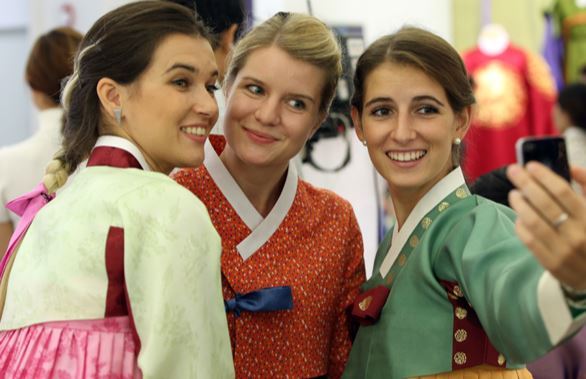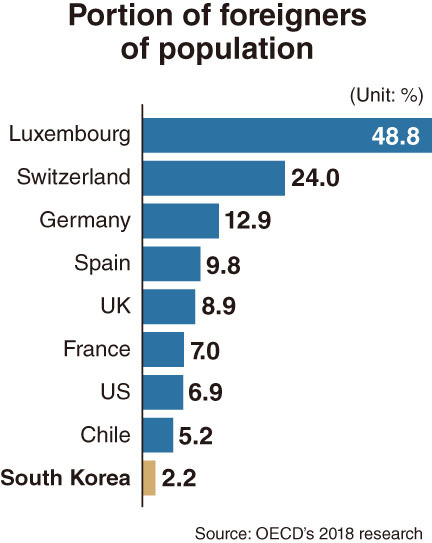
Foreign students take part in a hands-on “hanbok” festival, where they had a chance to try on Korea’s traditional costume, in downtown Seoul. (Yonhap)
SEJONG -- The number of foreign residents in South Korea has risen dramatically over the past few decades, during which the nation hosted major international sports festivals including the 1988 Seoul Summer Olympics and the 2002 FIFA World Cup, data showed.
But the data from the Organization for Economic Cooperation and Development showed that Korea has far fewer foreign residents in proportion to its population, compared with other member countries.
The OECD defines a foreign national as someone who still holds foreign nationality, whether or not they were born in the host country.
According to a comparison of 33 of the 36 OECD members, the average percentage of foreign residents came to 8.8 percent as of 2018 (or whenever the latest available data was posted for specific nations). Australia, Israel and New Zealand were not included in the research.
Korea ranked 26th among the 33 with only 2.2 percent of its population consisting of foreigners -- about 1.1 million people. The figure appears to have excluded short-term visitors and short-term migrant workers, given that the Justice Ministry of Korea said the total number of foreigners in Korea surpassed 2 million in 2016 and hovered near 2.5 million in 2019.
In any case, the figure for Korea fell far below those seen in most Western countries.
Luxembourg, which borders three countries, topped the list with 48.8 percent, followed by Switzerland, which is surrounded by five neighboring countries, with 24 percent.

(Graphic by Kim Sun-young/The Korea Herald)
Estonia ranked third with 16.3 percent, while Austria was fourth with 15.9 percent. Austria borders eight countries: Germany, the Czech Republic, Slovakia, Hungary, Slovenia, Italy, Switzerland and Liechtenstein.
The top 10 also included Latvia (14.1 percent), Germany (12.9 percent), Ireland (12.3 percent), Belgium (12 percent), Iceland (11.2 percent) and Norway (10.6 percent).
While the UK stood at No. 12 with 8.9 percent, just slightly above average for the 33 OECD members in the analysis, figures were below average for France (7 percent), the US (6.9 percent) and Canada (6.6 percent).
Among non-European countries, Chile was higher on the list than Korea with 5.2 percent of its population made up of foreigners. Others ranking higher than Korea included Sweden (8.9 percent), Denmark (8.7 percent), Italy (8.6 percent), Greece (6.1 percent), the Netherlands (6 percent), the Czech Republic (4.9 percent), Finland (4.5 percent) and Portugal (4 percent).
Japan ranked behind Korea, at No. 27, with 2 percent. Hungary was further behind with 1.6 percent, whereas Slovakia had 1.3 percent and Turkey had 1.1 percent. Three countries -- Lithuania (0.9 percent), Poland (0.6 percent) and Mexico (0.2 percent) -- posted figures under 1 percent.
The OECD clarified that the “foreign” population is different from the “foreign-born population,” which covers all people who have ever migrated from their countries of birth to their current countries of residence.
Meanwhile, some local demographic analysts -- citing research from the Justice Ministry of Korea -- forecast that the number of foreigners residing in Korea will reach 3 million in 2021 and make up 5.7 percent of the population.
But that projection refers to foreigners residing in the nation on a broader basis, not just the long-term foreign residents counted in the OECD data.
Meanwhile, the number of foreigners studying in Korea recorded a steep growth curve, according to the Justice Ministry.
The number of foreign students in Korea, which stood at 86,400 at the end of 2014, increased to 96,300 in 2015, 115,900 in 2016, 135,000 in 2017 and 160,600 in 2018.
Among the 160,600 students, Chinese, including Korean-Chinese, accounted for the largest proportion at 68,900, followed by Vietnamese at 45,100, Mongolians at 8,600 and Uzbeks at 7,800.
By Kim Yon-se (
kys@heraldcorp.com)







